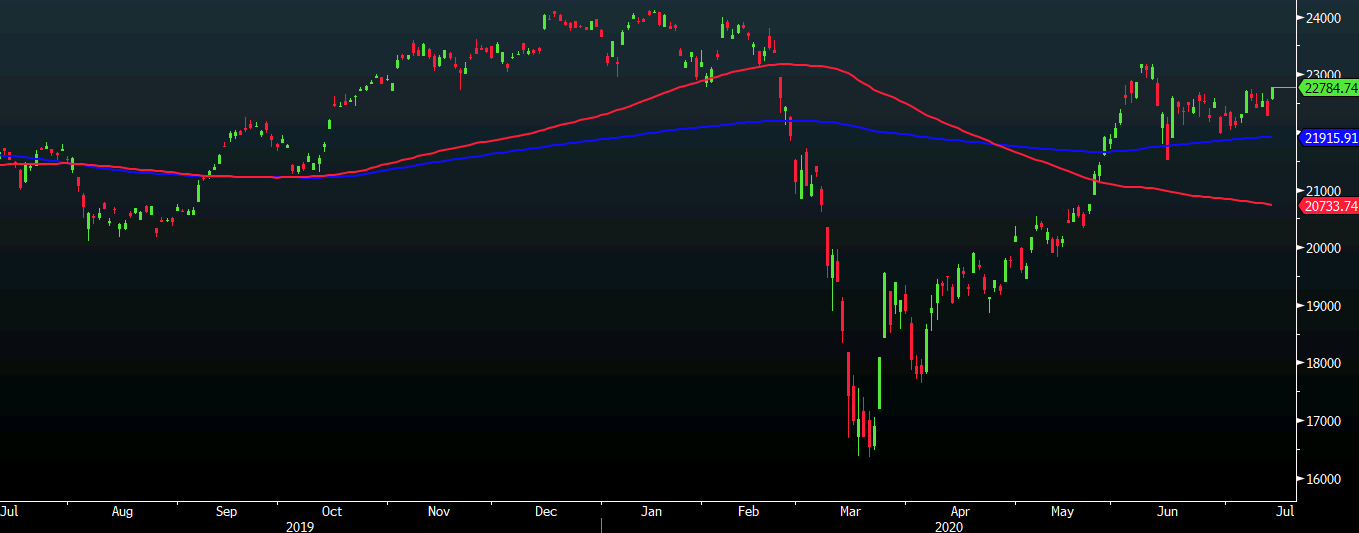re we looking at a repeat of the dollar melt up in 2016?

As Biden leads in the polls, almost everyone has been talking up the case for a ‘blue wave’ and what scenarios may take place should that happen.

As Biden leads in the polls, almost everyone has been talking up the case for a ‘blue wave’ and what scenarios may take place should that happen.

It has been a solid session for Asian equities, with the Nikkei closing at a one-month high while we are also seeing the Hang Seng post 1.1% gains and the Shanghai Composite also seen higher by 1.9% currently.
That enormous profits should have turned into still more colossal losses, that new theories should have been developed and later discredited, that unlimited optimism should have been succeeded by the deepest despair, are all in strict accord with age-old tradition. Benjamin Graham A trading philosophy is something that cannot just be transferred from one person to another; it’s something that you have to acquire yourself through time and effort. Richard Driehaus The essential element is that the markets are ultimately based on human psychology, and by charting the markets you’re merely converting human psychology into graphic representations. I believe that the human mind is more powerful than any computer in analyzing the implications of these price graphs. Al Weiss Opportunities change, strategies change, but people and psychology do not change. If trend-following systems don’t work well, something else will. There’s always money being lost, so someone out there has to win. Gil Blake, New Market Wizards |
1. OPTIMISM – It all starts with a hunch or a positive outlook leading us to buy a stock.
2. EXCITEMENT – Things start moving our way and we get giddy inside. We start to anticipate and hope that a possible success story is in the making.
3. THRILL – The market continues to be favorable and we just can’t help but start to feel a little “Smart.” At this point we have complete confidence in our trading system.
4. EUPHORIA – This marks the point of maximum financial risk but also maximum financial gain. Our investments turn into quick and easy profits, so we begin to ignore the basic concept of risk. We now start trading anything that we can get our hands on to make a buck.
5. ANXIETY – Oh no – it’s turning around! The markets start to show their first signs of taking your “hard earned” gains back. But having never seen this happen, we still remain ultra greedy and think the long-term trend is higher.
6. DENIAL – The markets don’t turn as quickly as we had hoped. There must be something wrong we think to ourselves. Our “long-term” view now shortens to a near-term hope of an improvement.
7. FEAR – Reality sets in that we are not as smart as we once thought. Instead of being confident in our trading we become confused. At this point we should get out with a small profit and move on but we don’t for some stupid reason.
8. DESPERATION – All gains have been lost at this point. We had our chance to profit and missed it. Not knowing how to act, we attempt to do anything that will bring our positions back into the black.
9. PANIC – The most emotional period by far. We are clueless and helpless. At this stage we feel like we are at the mercy of the market and have absolutely no control.
10. CAPITULATION – We have reached our breaking point and sell our positions at any price. So long as we can get out of the market to avoid bigger losses we are content.
11. DESPONDENCY – After exiting the markets we do not want to buy stocks ever again. The markets are not for us and should be avoided like the plague. However, this rare point marks thepoint of maximum financial opportunity.
12. DEPRESSION – We drink, cry and/or pray. How could we have been so dumb we think to ourselves. Some start to correctly look back and analyze what went wrong. Real traders are born here, learning from past mistakes.
13. HOPE – We can still do this! Eventually we return come to the realization the market actually does have cycles (shocking). We begin to start analyzing new opportunities.
14. RELIEF – The markets are turning positive again and we see our prior investment come back around. We regain our faith (although small) in our ability to invest our money. The cycle start all over again!
1. Believe in history: “history repeats and repeats, and forget it at your peril. All bubbles break, all investment frenzies pass away.”
2. Neither a lender nor a borrower be: “Unleveraged portfolios cannot be stopped out, leveraged portfolios can. Leverage reduces the investor’s critical asset: patience.”
3. Don’t put all your treasure in one boat: “This is about as obvious as any investment advice could be … Several different investments, the more the merrier, will give your portfolio resilience, the ability to withstand shocks.”
4. Be patient and focus on the long term: Wait for the good cards. If you’ve waited and waited some more until finally a very cheap market appears, this will be your margin of safety.”
5. Recognize your advantages over the professionals: “The individual is far better-positioned to wait patiently for the right pitch while paying no regard to what others are doing, which is almost impossible for professionals.”
6. Try to contain natural optimism: “optimism comes with a downside, especially for investors: optimists don’t like to hear bad news.” (more…)
 Hedge funds had nearly $20 billion pour into their coffers last month, as investors flocked back amid revived market optimism.
Hedge funds had nearly $20 billion pour into their coffers last month, as investors flocked back amid revived market optimism.
Hedge funds booked inflows of $19.6 billion in August, according to HedgeFund.net. Total hedge fund assets rose 2.56 percent, or $47.09 billion, to hit $1.886 trillion in August, the report said.
The influx of investments made August the third month in four that inflows outweighed outflows, HedgeFund.net said.
 Germans are feeling much better than expected about their economy, with the just-released ZEW sentiment index giving a reading of 42, up from 36.3 in July.
Germans are feeling much better than expected about their economy, with the just-released ZEW sentiment index giving a reading of 42, up from 36.3 in July.
The Zew Institute’s Current Conditions Index rose even more – to 18.3 from 10.6 in July.
Analysts expected readings of 40 and 12 respectively for the two indices and sentiment is at its highest since March.
The institute comments that the “first signs of an end to the recession in important Eurozone countries may have contributed to the indicator’s rise…. furthermore, the economic optimism is supported by the robust domestic demand in Germany”.
There has also been a strong increase in economic expectations for the Eurozone, the index climbing 11.2 points to 44.
Eurozone industrial production numbers for June are also out. They show an increase of 0.7 per cent, compared to economist expectations of 0.8 per cent and a decline of 0.3 per cent in May.
 You can be super motivated to trade, filled with deep optimism, have millions of trading capital available, and a solid trading strategy, but if you don’t devote your full concentration to the trade that you have on at the moment, you will lose money.
You can be super motivated to trade, filled with deep optimism, have millions of trading capital available, and a solid trading strategy, but if you don’t devote your full concentration to the trade that you have on at the moment, you will lose money.
It’s essential that you learn to concentrate while executing a trade and scrupulously monitor the market action during a trade
Why is concentration difficult? While in school did you have trouble studying in a noisy library? It’s easy to concentrate when we are in a quiet room and when we are calm and at ease. But trading is often chaotic and full of stress. It’s easy to become shaken and lose your ability to concentrate. When you aren’t fully focused on your ongoing experience, it’s easy for self-doubts to creep into your consciousness. You may start having second thoughts and may want to sabotage your trading efforts.
The more you can stay focused on your ongoing experience, the more you can trade effortlessly and skillfully. But how can you concentrate more easily? (more…)

 1) Cut Risk – It’s that “above all else, do no harm” principle. If you don’t have a feel for the market, trade small while you regain your feel. Preserve as much of your capital as possible to lay the foundation for your recovery;
1) Cut Risk – It’s that “above all else, do no harm” principle. If you don’t have a feel for the market, trade small while you regain your feel. Preserve as much of your capital as possible to lay the foundation for your recovery;
2) Focus on Your Strengths – It’s not unusual for frustrated traders to try to make all kinds of changes in their trading in a frantic effort to gain some traction. These efforts can compound difficulties by getting traders further and further from their strengths. During rebuilding periods, you want to focus on the markets and strategies that you know most about, that represent your strengths.
3) Reach Out – It’s especially helpful to reach out to traders who trade markets and strategies similar to yours. Are they also struggling? If so, this suggests that market changes, indeed, may be at the root of the problem. If the traders you contact are succeeding, try to find out what they’re doing differently from you. It may well be that a simple tweaking of execution, holding times, and risk management could turn your performance around.
4) Stay Constructive – You may well be in a rebuilding period. This happens to the best athletes and sports franchises. It doesn’t mean you’ve lost all talent and skill. Identifying the kinds of trades that are working for you is a start toward rebuilding: you want to find the common denominators behind your successful trades so that you can emphasize these going forward.
5) Work on Your Self-Talk – Hard as it is, it’s important to stay positive during a rebuilding period. The last thing you want to do is create additional interference by beating up on yourself and dampening your motivation. This is one of the areas where coaching can be helpful. Setting attainable goals and creating plans for learning new patterns and trading strategies can fuel optimism, determination, and focus.
6) Control the Budget – It very much helps to have a cash cushion to weather these rainy day periods. Living within one’s means also helps greatly. I’ve generally found that traders can adapt to shifting markets if they have enough time to make the transition. It’s when the pressures of bringing in money month to month add to the performance pressures of a drawdown period that turnarounds become difficult to sustain.
Perhaps the best advice, however, is preventive. Identify slumps early and control losses before they get out of hand. Perform regular inventories of your winning and losing trades, so that you’re always on top of what’s working for you and minimizing what’s hurting performance. During your best times, remember that markets always change and keep powder dry to weather the inevitable lean times. Ironically, the best way to master declines in trading performance is to embrace them early and turn them into prods for learning and development.